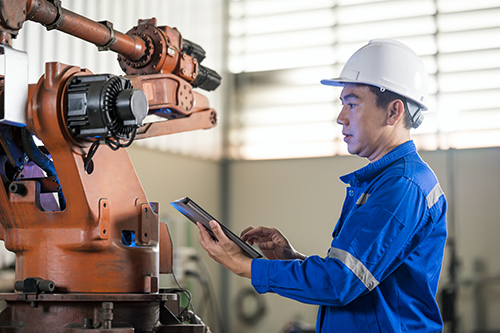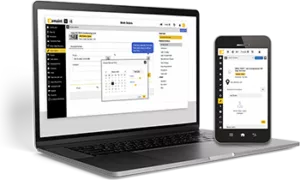Downtime significantly affects net earnings for any organization — regardless of whether it is planned or unplanned. According to an IDC survey, downtime can cost Fortune 1000 companies upwards of $1 million per hour.
Given the potential costs and profit losses downtime can cause, understanding maintainability is crucial. In this article, you’ll learn the core maintainability concepts and how they relate to reliability and availability, the most common methods of measuring maintainability, and the role a computerized maintenance management system (CMMS) plays.
What Is Maintainability?
Maintainability tells you how easily an asset or piece of equipment can be maintained to ensure optimal functionality within a larger system. Maintainability encompasses measuring and signaling maintenance needs, inspections, testing, calibration, and repair.
Maintainability refers to the ease with which an asset or piece of equipment can be maintained to ensure it continues to function as intended. This encompasses all activities related to keeping equipment in good working order, including inspection, testing, servicing, and repair.
The goal of maintainability is to reduce the time and resources required for maintenance activities, thus minimizing downtime and ensuring that equipment remains operational and productive.
What Is the Difference Between Maintainability and Maintenance?
Maintenance is the performance of proactive or corrective tasks to ensure optimal functionality and lifespan of your assets and properties. This includes upkeep performed at regular intervals, repair tasks to prevent potential failures, and corrective or emergency repairs.
Maintainability is simply the measure of how easy it is to perform maintenance on a given part, asset, or property.
Maintainability, Reliability, and Availability
While maintainability, reliability, and availability may seem interchangeable, they are distinct concepts. Simply put, maintainability and reliability work together to support availability, which supports facility uptime.
Maintainability measures how quickly and easily a piece of equipment can resume service after failure occurs. Maintainability varies based on asset importance, repair or replacement cost, and the broader impact of downtime. Regardless of its reliability, no asset is infallible; equipment with high maintainability ensures repairs are quick and efficient when the inevitable happens.
Reliability measures the likelihood that a particular asset will fulfill its intended purpose under standard conditions without failure. A piece of equipment has high reliability if it can run without unplanned downtime — an asset with low reliability is one that frequently causes unplanned downtime. Many factors affect reliability, but it generally comes down to the overall design and quality of the equipment.
Availability is reliability and maintainability combined. It represents the overall percentage of time an asset is available for use. Essentially, availability monitors real-time asset function and ability to complete intended tasks.
These metrics don’t operate in a vacuum. They work together to provide maintenance teams with valuable information about their assets, helping minimize downtime. In essence, maintainability is a tool to rely on when equipment failure inevitably occurs. When you have high maintainability in your facility, you can respond to unforeseen downtime and get back online quickly.
Methods of Measuring Asset Maintainability
Measuring maintainability depends on various factors that assess the ease and efficiency of maintenance activities. The most common key performance indicators (KPIs) relevant to maintainability include:
Calculating Maintainability With Mean Time to Repair (MTTR)
Mean Time to Repair (MTTR) indicates the average time needed to repair a piece of equipment to an operational state. MTTR measures time from the moment equipment fails until it functions once again.
Calculating MTTR requires four types of data:
- The total number of repairs performed on a piece of equipment over a given period.
- The total labor hours spent on repairs.
- The total time spent detecting a problem.
- The total time spent diagnosing the root cause(s) of the problem(s) leading
to failure.
Lower MTTR is desirable because it means higher maintainability due to the reduced amount of time it takes to make failed equipment operational again. Lower MTTR indicates less asset downtime.
Measuring Maintainability With Mean Time Between Failures (MTBF)
Mean Time Between Failures (MTBF) measures the average time an asset is operational before failing. MTBF and MTTR are commonly used in tandem to track system efficiency, identify system-wide failures, and promote a proactive approach to maintenance.
Tracking Maintainability With Total Maintenance Downtime
Total maintenance downtime measures the total time equipment is out of operation due to maintenance activities. Lower maintenance downtime indicates better maintainability, as equipment spends less time out of service.
Assessing Maintainability With Maintenance Task Complexity
Maintenance task complexity is determined by factors such as the number of steps involved, the need for specialized tools, and the level of skill required for the task. Simpler maintenance tasks indicate higher maintainability.
Monitoring Maintainability With Maintenance Frequency
Maintenance frequency measures how often maintenance activities are required. Lower maintenance frequency indicates better maintainability, as it suggests that equipment requires less frequent attention.
By using a combination of these KPIs, maintenance teams can gain valuable insight into the maintainability of individual pieces of equipment and entire systems. This is valuable for stakeholders who want to raisetheir bottom line and improve overall services to customers.
5 Factors That Impact Maintainability
So, what issues do maintenance professionals face when attempting efficient repairs and other maintenance practices? Here are five of the most common challenges and how to start tackling them.
1. Disorganized Records and Maintenance Processes
When project teams can’t access maintenance documentation, drawings, manuals, and other essential records, it’s impossible to achieve lasting maintainability. They waste time and effort searching for the information they need.
Start with standardizing documents and processes. Dispose of any outdated manuals, drawings, or other records that are no longer relevant to your assets or processes. Next, develop standardized operating procedures (SOPs) for consistent and reliable practices across teams, along with centralized documentation ensuring simple, efficient access to reference materials.
Comprehensive software systems, such as a CMMS, can help streamline these resources.
2. Improper Training in Maintenance Management and Inventory Management
Does your team understand official procedures and best practices? Are they familiar with your equipment? If not, you have a training issue — and maintainability is at stake.
Adopt a continuous improvement approach to learning with regular training and re-education initiatives. With this practice in place, you can quickly identify knowledge gaps, teach critical skills, and improve employee effectiveness.
3. Aging Assets
While older equipment may retain full functionality for many years, it presents unique maintainability challenges.
For example, condition-based monitoring tools and Internet of Things (IoT) connectivity are relatively new features that can flag potential failure modes before external signs emerge. But your aging assets may not have these features, leading to more corrective maintenance, higher repair costs, and catastrophic damage requiring full replacement.
What’s more, manufacturers may discontinue essential spare parts for these assets. When that happens, it may force you to upgrade assets before you would need to under normal operating conditions.
4. Complex Equipment and Inventory
Unstandardized or overly complex assets increase repair costs and time. For example, you’ll likely need to order parts from a larger number of manufacturers, multiplying any supply chain issues and lead times. Also, teams lose time switching between disparate manuals, part types, and repair methods across mismatched assets.
But when you choose systems designed for interchangeability, otherwise known as modular systems, you simplify the whole process. One of the best benefits? The ability to bring part of an asset offline for repairs, while the rest of the asset continues normal functionality. This capability improves uptime and productivity.
5. Overreliance on Reactive Maintenance Strategies
When you first increase proactive processes, including preventive and predictive tasks, it may seem like additional work. But by adding some time upfront and pre-planning any downtime, you save time and improve asset maintainability.
Think of it this way: Let’s say a routine asset inspection takes 30 minutes to complete. One day, a technician spots a piece of equipment that looks like it’s about to fail. They flag the issue, ensure necessary parts and tools are available, and schedule a 30-minute repair. That work prevents unplanned downtime that could have taken hours to remedy — plus potential days spent waiting for an out-of-stock part to arrive.
If you could spend 60 minutes this week to prevent multiple days of unexpected downtime, wouldn’t you do it?
Best Practices to Sustain and Improve Maintainability
In addition to the KPIs measuring maintainability, there are several best practices you can implement to support high maintainability at your facility.
- Design simplicity: Generally, it is easier to maintain equipment with simpler designs. This means components are accessible, and assembly and disassembly are straightforward and intuitive.
- Standardization: Equipment that uses standard parts and procedures throughout the facility improves maintainability. By having standard components that are easy to source and common methods of repair, you can simplify training efforts and be ready to respond to issues without delay.
- Documentation: Quality documentation helps maintenance teams efficiently and accurately understand standardized procedures and specifications. Comprehensive and clear maintenance manuals, services guides, and other documentation channels are imperative.
- Training: Well-trained maintenance staff can perform tasks more efficiently and effectively, reducing downtime and improving overall equipment.
- Modularization and isolation: By designing complex machines and systems on smaller modules (building blocks), you can maintain each module independently. This allows your maintenance teams to isolate issues and diagnose problems
more easily. - Improve inventory management: An accurate and up-to-date record of all spare parts and maintenance supplies increases transparency on stock levels for maintenance teams, as well as usage rates. This ensures parts are available when repairs are necessary.
- Interchangeability: This coincides with inventory management. By having standard parts that are easy to acquire and usable system-wide, you reduce inventory costs and make repair jobs easier for the maintenance teams since they do not have to hunt for proprietary or specialized parts.
Manage and Measure Maintainability With a CMMS
While it is possible to measure and manage maintainability manually or through your own means, CMMS software is a valuable, comprehensive solution. It contains a set of tools and features that streamline maintenance activities and enhance efficiency. eMaint CMMS can help your maintainability efforts through:
- Centralized maintenance data: A CMMS is a hub for all maintenance-related information, including equipment history, work orders, and maintenance schedules. This centralization makes it easier to track and manage maintenance activities compared to teams using paper-based or fragmented systems to conduct maintenance. With a CMMS, improved data accessibility and organization enhance maintenance task planning and execution while boosting efficiency.
- Automated work orders: A CMMS can automate work order creation and assignment based on predefined criteria or real-time data. Automation ensures that maintenance tasks are promptly addressed, reducing delays and improving response times.
- Enhanced predictive maintenance: Advanced CMMS systems use predictive analytics to forecast potential equipment failures based on historical and real-time data. This strategy helps anticipate issues before they occur, enabling proactive maintenance and less downtime.
- Streamlined inventory management: Managing spare parts is easier than ever with a CMMS thanks to tracking features that ensure the necessary components are available when needed. Efficient inventory management prevents delays in maintenance activities and reduces the risk of stockouts.
- Reporting and analytics: Teams can generate detailed reports and analytics on maintenance activities, equipment performance, and maintenance costs with a CMMS. Comprehensive reporting provides insights into maintainability metrics, helping organizations identify trends and areas of improvement.
- Access on the go: Many CMMS solutions offer a mobile app, allowing maintenance personnel to access work orders, equipment information, and maintenance history from cell phones and tablets. Mobile access enhances flexibility and efficiency in performing maintenance tasks, reducing downtime, and improving maintainability.
A CMMS is a powerful tool that streamlines maintenance processes and produces gainful insights for continuous improvement. When you implement a CMMS at your facility, it will reduce downtime and improve the overall asset lifespan and efficiency.



